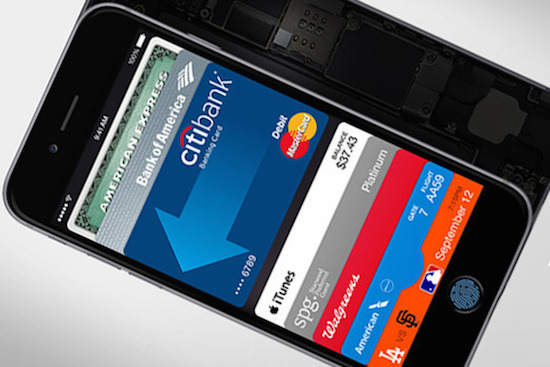
When Apple unveiled the iPhone 6, and gave us our first glimpse of the Apple Watch, last month, they also took the wraps off a new service called Apple Pay. A digital wallet of sorts, Apple Pay promises to revolutionize the way we make purchases, while also providing a level of security that hasn’t been possible in the past.
Exactly how does the system work, and will it really revolutionize the way we shop?
Read on for the answers.
While Apple would like you to believe that the technology behind Apple Pay is revolutionary in some way, the reality is that it has been around for some time. The new iPhone 6 and 6+ come equipped with Near Field Communications (NFC) antennas that enable them to interact with other NFC devices, most notably the “tap to pay” systems that already exist in countless retail outlets, convenience stores, and grocery marts.
This technology isn’t new, as there are a number of Android and Windows phones that utilize NFC already, and Google’s own Wallet service is similar to Apple Pay in many ways.
Apple has made the process more streamlined and secure however, which should help to give Apple Pay a boost over similar offerings from competitors. To use the service, you’ll simply hold your iPhone close to an NFC-enabled contactless payment device, with your thumb over the Touch ID reader. The purchase is then made quickly, and securely, without ever having to wake the screen on your iPhone. A distinctive vibration and beep will inform you that the purchase as been made successfully. There will no longer be a need to pull out your wallet, swipe a card, or enter a PIN number.

Increased Security
In the wake of the major security breach at Target last year, which saw more than 40 million credit card numbers stolen, there have been increased concerns over how, and where, we make our purchases.
Apple says their new service is far more secure than actually swiping your card, because none of your personal information or credit card numbers will be used in the process. Instead, each purchase will have its own unique identification key and transaction number, with all of the charges being made securely on the backend. Even the iPhone won’t store the credit card number, as it is simply verified with the bank that issued it, and a unique “Device Account Number” is generated for use with Apple Pay instead. With no credit card numbers used at any step of the process, even if the system is hacked, there won’t be any useful information to be stolen.
Apple promises that this entire process will be incredibly simple and fast, but since it isn’t operational yet, we’ll have to wait to see if that is true. Apple Pay is scheduled to go live sometime this month, following the release of iOS 8.1. That software update will give users the ability to store credit cards in Passbook, and begin using the service with their NFC equipped iPhone. When the Apple Watch is released in early 2015, it will also be Apple Pay compatible.
Apple says at launch more than 220,000 outlets will be Apple Pay compatible, including McDonalds, Disney, Bloomingdales, Walgreens, Subway, and of course their own retail outlets.
Life Changing?
One of the reasons why NFC, and contactless payment systems, haven’t taken off in the past is because the companies pushing them didn’t have the clout to force adoption. That won’t be the case with Apple, whose entry into the market is likely to spur retail establishments to embrace the technology more fully. Look for Apple Pay to be available just about everywhere in time, freeing you up to leave your wallet at home, and make the majority of your purchases by using your iPhone.
The speed and convenience that comes along with Apple Pay should not be overlooked either. In a world where time is increasingly of the essence, being able to make purchases quickly and easily will be seen as a godsend by many consumers. If the system works as advertised, it could cut down on the time that you wait in line, and make shopping in general more efficient.
If you’ve ever had your credit card information stolen, then you’ll understand that the level of security that Apple Pay uses is truly the life changing element that the service delivers. When making purchases – both online and at brick and mortar outlets –you’ll no longer have to fear that information falling into the wrong hands. That alone should make it appealing to consumers, particularly in the wake of high profile data breaches like the ones that occurred at Target and Home Depot. With Apple Pay, you’ll never have to worry about that happening to you ever again.
In just a few short weeks, Apple Pay will go live, and we’ll all get the chance to see how it performs. If is the life changing service that Apple promises? We’ll soon find out.
Also read:





2 thoughts on “How Apple Pay Will Work, and How It Will Change Your Life”
How will it work in a restaurant? Do you give your phone to a waiter or does the waiter bring a reader to your table?
Hard to say exactly at this point Benjamin, but I know McDonalds is using a portable NFC scanner at the drive through to allow Apple Pay users to make payments. I imagine restaurants could do the same. Giving your phone to a waiter won’t be an option however, as the Apple Pay credit card is linked to your Touch ID fingerprint.